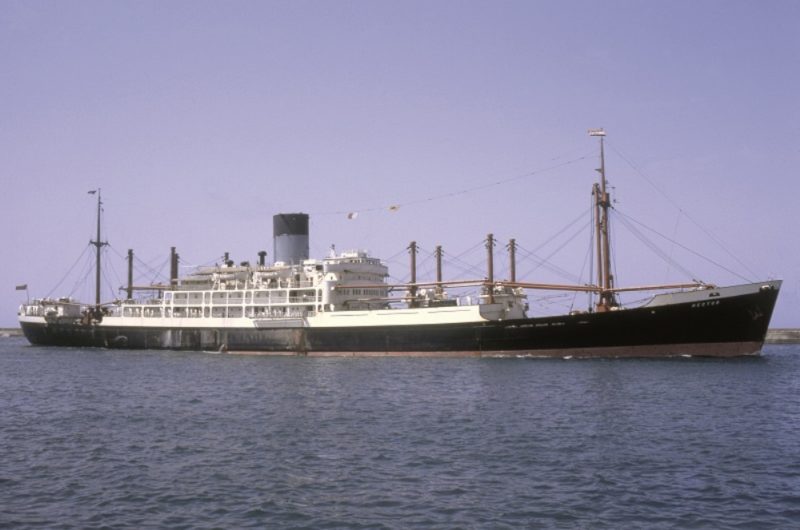
Blue Funnel Line was one of the finest British shipping lines to sail for, with training ships and the ‘Aulis’shore training school at Liverpool, and a structured study and learning system on board for cadets that was unrivalled in other companies. My own memories come from my uncle Robert Middlemiss, a sea going engineer with the company, and the procession of inward bound ships arriving at the Gladstone Dock and its branches to discharge part of their cargo, and sign on a coasting crew to Dublin, Glasgow, Rotterdam, Antwerp and Hamburg, before returning to the Vittoria Dock in Birkenhead near the Clan Line berths and the overflow Cathcart Street berths to load for the Far East, with the Odyssey Works base of the company also at Birkenhead.
The huge losses of 41 vessels and 324 lives of brave crews suffered by the company during World War II necessitated a very big new building programme to make up these losses, with the ‘A’ class of 21 cargo-liners plus another fifteen later similar ships, three cargo-liners taken over on the stocks from Silver Line and renamed Ulysses, Telemachus and Teucer, and eight ‘P’ and ‘H’ class passenger and cargo ships, with the quartet of the ‘P’ class for the Far East run, and the quartet of the ‘H’ class for the Australian run. The ‘A’ class and later similar ships comprised Calchas, Anchises, Aeneas, Agapenor, Achilles, Astyanax, Clytoneus, Cyclops, Autolycus, Antilochus, Automedon, Laertes, Bellerophon, Ascanius, Atreus, Alcinous,Laomedon, Eumaeus, Adrastus, Elpenor, Lycaon, Nestor, Neleus, Theseus, Demodocus, Diomed, Dolius,Antenor, Achilles (the previous Achilles had transferred to the Dutch ‘Oceaan’ subsidiary), Ajax, Menelaus,Menestheus, Machaon, Memnon, Melampus and Maron. These diesel powered cargo-liners had service speeds of fifteen to sixteen knots, the fastest that could be built at that time, but Lawrence Durning Holt, the owner of Blue Funnel Line and nephew of founder Alfred Holt (1829-1911), wanted Blue Funnel Line to have the fastest post-war ships on the Far East and Australian runs, and so the ‘P’ and ‘H’ classes were steam turbine propelled with speeds approaching twenty knots when ‘flat out’ at full speed.
The homeward cargo trade to Liverpool in 1950 of Blue Funnel Line was 453,000 tons, and the outward cargo trade from Birkenhead was 625,000 tons, so there was plenty of work for this new fleet. The ‘H’ class had accommodation for thirty First Class passengers and four children, with the ‘P’ class having accommodation for 35 First Class passengers plus four children, but the ‘H’ class sailed on the joint service of the Blue Funnel Line and Shaw, Savill and Albion Co. Ltd., a noted passenger and cargo carrying company with much experience to Australia.
DESIGN and SPECIFICATIONS
The orders for this octet of fine passenger and cargo-liners was spread around the great shipbuilding companies of Britain, with three going to the Belfast yard of Harland & Wolff Ltd. (Helenus, Hector andIxion), two to Cammell, Laird & Co. Ltd. at Birkenhead (Peleus and Pyrrhus), two to the Walker Naval Yardon the Tyne of Vickers-Armstrong Ltd. (Patroclus and Perseus), and one to the Wallsend yard of Swan,Hunter and Wigham Richardson Ltd. (Jason). They had a full scantling design with transverse bulkheads,widely spread tubular deck pillars, and multi tubular cellular double bottoms. The ‘P’ class had dimensions of overall length of 515.8 feet, moulded beam of 68.4 feet, and a loaded draft of 25.3 feet as an open shelter decker and 30.9 feet as a closed shelter decker. The ‘P’ quartet had two decks with a third lower deck in the forward holds, ten bulkheads, six holds and six hatches. The latter consisted of two steel hatches with dimensions 32.5 feet by 24.0 feet and 24.0 feet by 16.0 feet, and four wooden hatches with dimensions of two at 27.0 feet by 24.0 feet, and two at 27.25 feet by 18.0 feet. The fo’c’stle varied in length from 54 to 59 feet, the Bridge Deck was of length 221 feet except for Peleus where it was 235 feet, and the poop deck varied in length from 25 feet to 55 feet.
There were 26 derricks to serve the six holds, consisting of one 50 tonne heavy lift derrick on the foremast to serve number two hold, one 20 tonner, eight 10 tonners and sixteen five tonne derricks, all operated by 26 Laurence Scott winches varying from three to eight tonne capacity. The hulls were of rivetted and welded construction and carried insulated compartments for refrigerated cargo, and a deep tank was fitted ‘midships for the carriage of latex and vegetable oils with a flashpoint above 150 degrees Fahrenheit.
The ‘H’ class steel hulls were seven feet longer and one foot wider than the ‘P’ class and were subdivided by nine bulkheads into seven holds and seven hatches. The latter measured 29 by 22 feet, 27by 24 feet, 27 by 22 feet, two of 26 by 22 feet, one of 18 by 12 feet, and one of 14 by 12 feet. The foc’stle of all of this quartet measured 47.0 feet, the Bridge Deck was of 265.0 feet in length, and the poop deck was 26.0 feet in length. The hulls were of riveted and welded construction and carried insulated compartments for refrigerated cargo, and a deep tank was fitted ‘midships for the carriage of latex and vegetable oils with a flashpoint above 150 degrees Fahrenheit. The cargo handling gear consisted of a heavy lift derrick of 50 tons capacity on the foremast to serve number two hold, four ten tonners, fours even tonners, and sixteen five tonne derricks, a total of 25 derricks, all operated by 25 Laurence Scott winches varying from three to eight tons capacity.
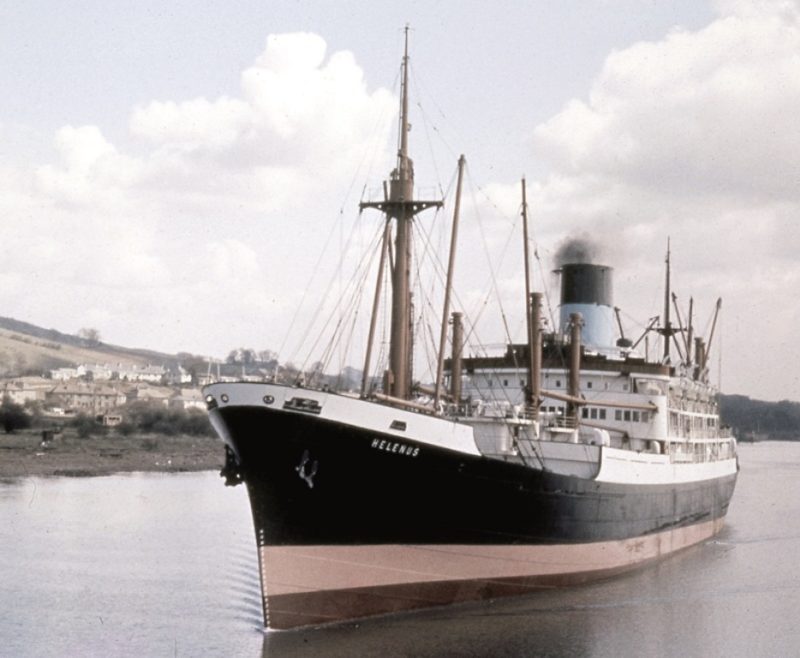
The ‘P’ and ‘H’ classes were completed to the highest classification of Lloyd’s Register, and their propelling machinery was built and classed to British Corporation Rules under the supervision of Lloyd’s Register. Fortunately, the propelling machinery was identical for all eight ships, and consisted of three Parsons steam turbines of 15,000 shp at 106 rpm, double reduction geared to a single screw shaft, taking steam from two Foster Wheeler water tube boilers operating at 570 pounds/sq. inch and 850 degrees Fahrenheit to give a service speed of 18.5 knots and a ‘flat out’ speed of over 20 knots. The turbines either had impulse blading or reaction blading depending on use for ahead or astern steaming, and the boilers had air heaters and economisers, together with the necessary fans for forced and induced draught. The boiler room floor was slightly above and directly accessible from the turbine manoeuvring platform.
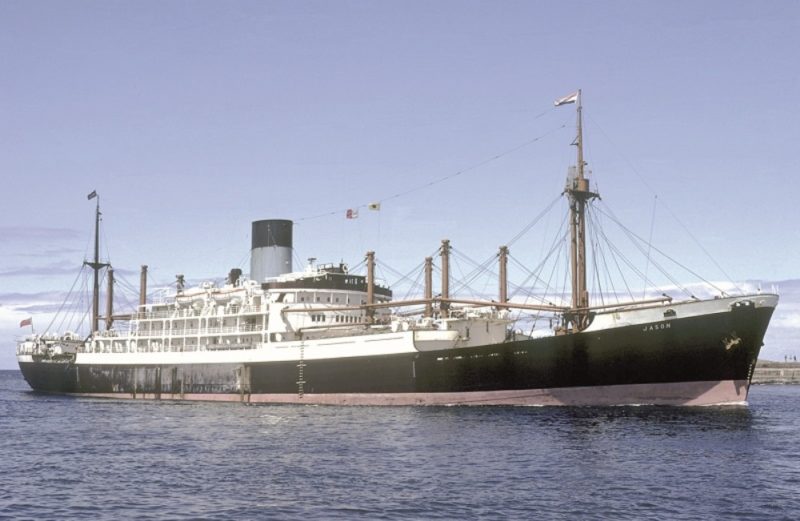
The solid four bladed propeller was made of brass, and the thrust block was of the Michell type, and was fitted immediately aft of the gear case. The gears were of the interleaved type, and the lower portion of the gear case was incorporated in the structure of the ship. The main condenser was of there generative type and suspended beneath the low pressure turbine casing, and was designed to maintain a vacuum under service conditions. Oil fuel double bottom tanks, side compartments and settling tanks carried between 2,190 and 2,396 tons of fuel, and the water ballast carried in several compartments including the fore peak and aftpeak totalled around 3,500 tons. Three DC generator sets of 350 kW and 240 volts were driven by four stroke cycle diesel engines and produced electricity for use throughout the ship, and there was an auxiliary steam driven generator set for emergency use.
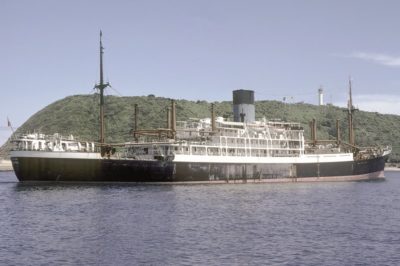
All eight vessels of these two classes had well raked and rounded bows, cruiser sterns, two masts and an elliptical funnel. The slots on the top of the forward side of the funnel were designed to clear smoke away from the aft decks and the docking bridge on the poop, and were later removed.
The gross tonnage of the ‘P’ class was 10,093 with a deadweight tonnage of 11,250 as a closed shelter decker, and the measurements for the ‘H’ class were 10,125 grt and 11,500 dwt, with more refrigerated compartments, including all of numbers 3 and 4 holds, in the ‘H’ class to reflect the importance of food exports from Australia. A distant reading thermometer installation was fitted for the refrigerated compartments.
All of the octet carried big crews of 83 people consisting of Master, 7 navigating officers, 7 engineer officers, purser, radio officer, doctor, nurse, 22 deck ratings, 22 catering ratings, and 18 Chinese engine room ratings and two cadets.
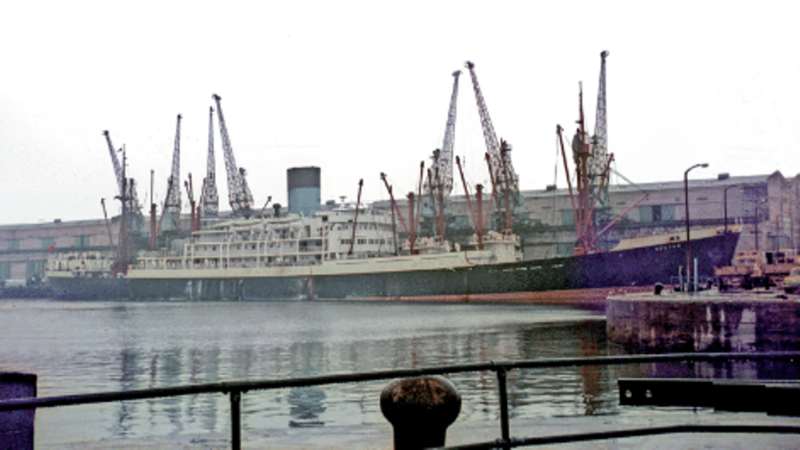
The Master had his cabin, day room and bedroom on the Boat Deck, together with the cabins for the radio officer and navigating officers, and there was also a cabin for the owner or his guests on this deck. There were six lifeboats provided on each ship of the ‘P’ and ‘H’ classes of length 26 feet, with one motor driven, and carried on mechanical davits.
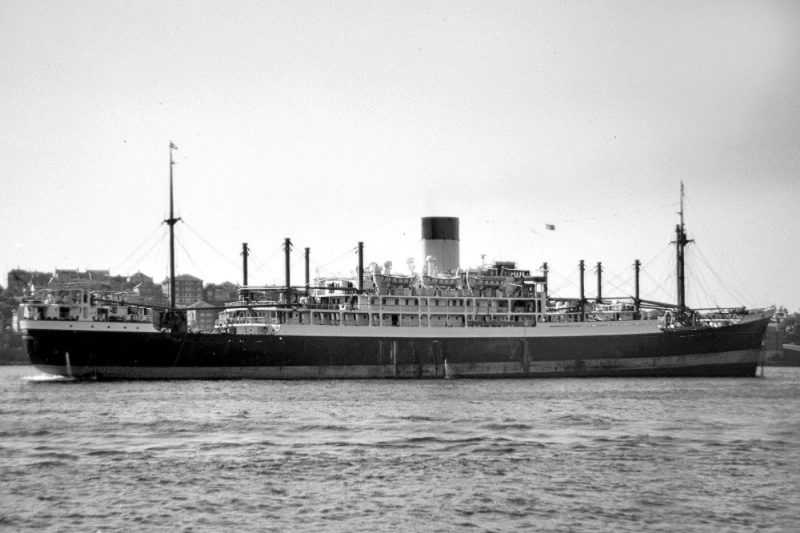

DECK ARRANGEMENT and PUBLIC ROOMS
The central superstructure of all eight ships had four decks, in the long Upper Deck, with the Bridge or Centrecastle Deck, the Promenade and Boat Decks above, and topped off with the navigating bridge and monkey island above with the radar installation at the rear of the latter. The navigating bridge consisted of the wheelhouse and chartroom to the rear, and aft of the exhaust uptakes and funnel there were ten ventilators. In the holds, the two steel decks below Upper Deck were named Main Deck and Tunnel Deck.
Upper Deck had the windlass and anchor motor rooms in the fo’c’stle, with insulated storerooms and stores forward of the exhaust uptakes, and cargo spaces aft. Moving aft to the poop deck, there were cargo spaces and crew lavatories above the steering gear on the deck below, and on the Docking Bridge above Upper Deck were the Chinese engine room ratings, greasers and fitters, together with the bosun’s store and the ship’s hospital. Bridge or Centrecastle Deck had the Passenger Dining Room forward and extending to the full width of the ship with the pantry behind, and aft of the exhaust uptakes were the dynamo room, crew accommodation and crew lavatories.
Promenade Deck had the Main Lounge forward and extending to the full width of the ship, with the Lounge Recess Room having a bar and dining cutlery and bar cupboards behind the Main Lounge. The passenger staterooms were then to port and starboard aft of these two lounges, with a few staterooms to the rear of the central lavatories.
Boat Deck had the Masters day room, bedroom and office to port and centre of the forward part, with the First Officer on the starboard side, and then the Engineer Officer cabins to port and Deck Officer and Radio Officer cabins to starboard. The doctor’s cabin and medical nurse room were also on this deck, with the Officers Mess in a central position to the rear for both engineer and navigating officers, and also their lavatories.
Passenger Dining Room at the forward end of Bridge or Centrecastle Deck was very elegant and had three long tables each set for ten people to give the maximum of interaction between the thirty passengers. The side serving tables had glass mirrors above etched with drawings of turtles, birds, animals and sea creatures. The lower part of the panelled walls had wooden ventilators decorated with sea creatures, and there were beautiful striped curtains to the windows.
Main Passenger Lounge had a large rectangular mural scene with twelve images of sea shells, sea horses, starfish and other maritime creatures as well as the name of the ship and a marquetry clock made from satinwood and birchwood inlaid with exotic woods above the fireplace with electric fire. Beautiful dark blue patterned carpets had many comfortable carver chairs and sofas arranged for maximum social interaction.
Passenger Recess Lounge behind the Main Lounge had a bar of very modern design with a mirror at the back of the bar etched with Greek mythological beasts. The bar front was made out of three layers of different exotic woods with apertures in the upper layer designed for the comfort of passengers sitting on bar stools.
The Double berth First Class passenger staterooms were arranged on the Promenade Deck in eighteen staterooms that extended to the end of the deck and were trunked around number four hatch on the ‘P’class and number five hold in the ‘H’ class, all of which also had cot beds. A pullman berth was provided in four of the single berth and two of the two berth cabins, with comfortable carver chairs and rectangular windows, not portholes. Ten of the staterooms had private bathrooms, and there were also a small Entrance Lounge, and a nursery. The main stairwell had a large cut glass mirror depicting a Greek Odyssey scene.

The Master’s Day Room had a large writing desk with several drawers on either side of the leg access, four carver chairs, square and round tables for visitors, and a very large double bookcase above a set of long drawers to take maritime tables and books. The navigating bridge had a full outfit of the latest equipment including radar, radio telegraphy, gyro compass, magnetic compass, echo sounding gear, rudder indicator, revolution indicator and other vital instruments to monitor the temperature of the refrigerated cargo.
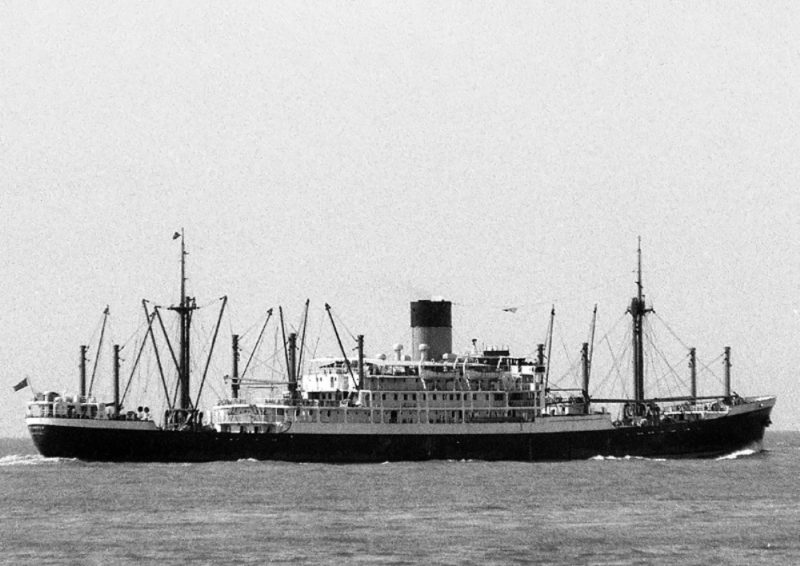
The main switchboard in the engine room had a tripping arrangement to supervise the distribution of electricity in the event of the main generators being overloaded. An emergency battery was provided for the electrically driven steering gear, and the total number of light bulbs in the vessels was around one thousand, with special lights in the holds together with a 24 inch searchlight. A total of 102 motors was provided in each ship to operate the engine room equipment, feed pumps, generators and other equipment, with the low power installation supplied from twin 24 volt 120 amp hour batteries through a switchboard arranged to permit one battery to be charged while the other was in service.
The main profile identification difference between the two classes was that the forward extension of the Bridge (or Centrecastle) Deck on the ‘P’ class at number three hold was extended further forward in the ‘H’ class to encompass both numbers 3 and 4 holds. There were thus two sets of kingposts on this raised extension in the case of the ‘H’ class. The hull paint scheme was black with white fo’c’stle, centrecastle and poop, with the name and port of registry in embossed white 14 inch block capitals at the stern. The pink or red boot topping extended from a line below the port of registry to a line above the draft marks, and below that was a composite coloured lower hull with the same colour for the stern post and rudder. The masts were painted brown as were the forward kingposts, while the aft kingposts were at first white and later changed to brown. The steam turbines were very smooth running throughout all of their careers, and more reliable than the diesel engined ‘A’ class, with each of the turbine installations of the octet having the highest shaft horse power turbines of any vessel afloat on completion. The ‘P’ class could reach Singapore in twenty days, ten days better than the company service pre-war, and much better than competitors, although there was stiff competition from Ben Line of Leith and Continental ship owners. A two month round voyage was provided by each of the four ‘P’ class, but the penalty was that they were every heavy on fuel oil, burning 65 tons per day.

THE ‘P’ and ‘H’ CLASS CARGO-LINERS INSERVICE
The ‘H’ class sailed on the route to Australia via Santa Cruz de Tenerife or Las Palmas de Gran Canaria to Cape Town, Durban on some voyages, Fremantle, Albany, Adelaide, Melbourne, Sydney and Brisbane, each return voyage taking three months. The calls at Cape Town were ended in early 1956 and the ‘H’ class then went through the Mediterranean to Suez and Aden and on to Australian ports. The ‘P’ class sailed to the Far East via Mediterranean ports, the Suez Canal, Port Swettenham, Penang, Singapore, Hong Kong, Shanghai and Japanese ports. Indonesian port calls may have been included to give a return voyage of three to four months. The maiden voyages of the octet were as follows:-
Helenus was launched at Belfast on 13th April 1949 and sailed from Liverpool on 12th November 1949, having been delayed for three days at Liverpool by a fire onshore, while Helenus and Dardanus were loading at No. 2 branch Gladstone Dock and sister Pyrrhus and Calchas were discharging at No. 1 branch Gladstone Dock. Helenus and Dardanus had to sail partly loaded, and sister Pyrrhus and Calchas were moved to safer berths.
Jason was launched by Lady Gosse accompanied by her husband Sir James Hay Gosse (1876-1952), an Australian businessman, importer and exporter, sportsman and philanthropist, at the West or Neptune yard of Swan, Hunter and Wigham Richardson Ltd. on 6th June 1949. The keel had been laid on 23rd December 1947, with framing begun on 13th February 1948 with framing complete on 30th March 1949 and the hull plating completed on 3rd June 1949. Trials were run over the Newbiggin Measured Mile on 26th January 1950 and she was handed over on 27th January 1950, and sailed from Liverpool on 19th February 1950 for Australia. She cost £1,335,367 to build with a further £460 for modifications to the cooler drain valve gearing, which entailed removing and then replacing the insulation after the modifications were completed.
Hector was launched at Belfast in July 1949 by Prime Minister Clement Atlee and was completed in March 1950 and sailed from Liverpool on 25th April 1950 for Australia.
Ixion was ready at Belfast in January 1951 and sailed within a month from Liverpool to Australia as the sixth Blue Funnel Line ship to be built at Belfast after the war.
Peleus was launched at Birkenhead on 3rd September 1948 and completed during 1949 to make her maiden voyage to Australia instead of the intended Far East route, at the end of which she loaded for the Far East. She was the favourite vessel of the ‘P’ class for her crews, in that her schedule always allowed for her to be home in the Mersey for Christmas, Easter and August Bank holidays.
Pyrrhus completed at Belfast in July 1949 and on her return from her maiden voyage she was involved with Helenus in a fire onshore at Liverpool.
Patroclus was launched on 8th July 1949 and completed at Newcastle on 22nd January 1950 and made her maiden voyage from the Mersey on 11th February 1950 to the Far East.
Perseus was launched at Newcastle on 22nd October 1949 and was completed on 4th April 1950 and sailed from the Mersey on 21st April 1950 on her maiden voyage to the Far East.
During the second half of 1954, the ‘H’ class quartet continued the loading of wool, bundles of sawn timber, frozen lamb carcasses, barrels of wine and other Australian cargo loaded in several ports including the single pier at Albany, and the docks upriver from the magnificent Sydney Harbour Bridge. Annual dry dockings were nearly always done on the Clyde, and their regular sailings from Birkenhead at this time were:-
- Jason: 12.5.1954 – 28.9.1954
- Helenus: 22.6.1954 – 9.11.1954
- Hector:20.7.1954 – 7.12.1954
- Ixion: 17.8.1954
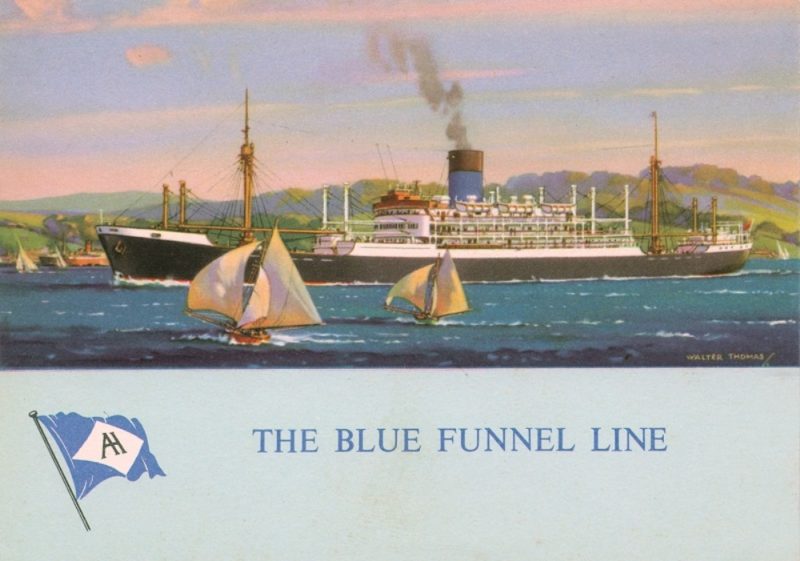
The Suez Canal was closed during November 1956 to April 1957, and the ‘H’ class quartet had again to take the longer route out to Australian ports via Cape Town instead of the Suez Canal, and they returned to the Mersey via the Pacific, Panama Canal and northern ports of South America. Helenus suffered a rare breakdown in the Pacific on one of these long voyages with a fire in a generator. In 1960, Jason carried the Australian Equestrian Team from Sydney (NSW) to the Rome Olympic Games, with a specially constructed paddock on one of the hatches to allow the horses to be exercised. Jason was particularly appropriate to be selected for this honour, in that the Greek mythological Jason was the leader of the Argonauts and had been brought up by a half man, half horse beast called the Centaur. The ‘P’ and ‘H’ classes had completed almost forty round voyages by the end of 1959, and their arrival dates back at Liverpool for the ‘P’ class in the last quarter of 1959 were:-
- Patroclus – 9.9.1959 from Japanese ports via Hong Kong, Manila, Port Swettenham, Colombo and Port Said.
- Perseus – 8.10.1959 from Japanese ports via Hong Kong, Port Swettenham. Colombo and Port Said.
- Pyrrhus – 7.11.1959 from Japanese ports via Hong Kong, Manila, Port Swettenham, Colombo and Port Said.
- Peleus – 8.12.1959 from Japanese ports via Hong Kong, Port Swettenham, Colombo and Port Said.
- Helenus – 7.10.1959 from Australian ports via Dunkirk and Antwerp.Hector13.10.1959 from Australian ports via Genoa.
- Ixion – 15.12.1959 from Australian ports via Dunkirk and Antwerp.
- Jason – 5.1.1960 from Australian ports via Genoa.
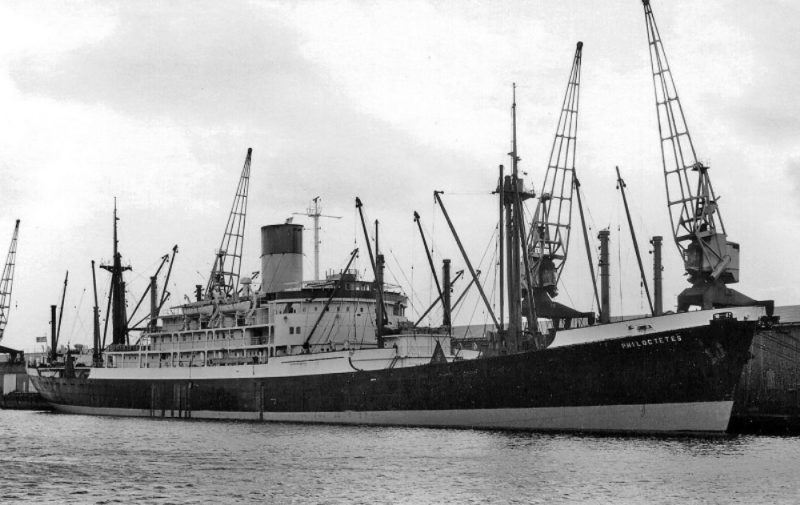
However, passenger numbers were falling fast due to air travel, and by the mid 1960s hardly more than half a dozen passengers made up the sailing list. Thus in 1967, passenger carrying was abandoned on all eight vessels, with no doctor carried, the catering ratings slashed by one half to only eleven, the deck ratings down from 22 to 15, and the Chinese engine room ratings down to only a dozen from eighteen. The two aft lifeboats were removed from the Boat Deck. Pyrrhus had suffered a very bad fire on board in the Huskisson Dock at Liverpool on 12th November 1964, with huge amounts of water poured by the fire crews, who took twelve hours to control the flames and another twelve hours to extinguish the flames, with the stability of the ship in question on more than one occasion. However, she was repaired and continued in service for another eight years. The centenary year of Blue Funnel Line in 1965 saw the company become publicly quoted on the London Stock Exchange, and the beginnings of diversification away from liner shipping.
The closure of the Suez Canal in July 1967 for over seven years forced the transfer of the ‘P’ class to sail from Liverpool westbound to Curacao for bunkers and then through the Panama Canal to Japan, Korea, Hong Kong, Singapore, Colombo and then down to Durban and Cape Town before calling at Santa Cruz de Tenerife or Las Palmas de Gran Canaria to bunker before arriving back in the Mersey. The ‘P’ class continued on their worldwide voyages, with Perseus sailing from Birkenhead on 28th February 1969 westwards to Curacao for bunkers and then through the Panama Canal to Yokohama, Kobe, Osaka, Pusan, Chilung (Taiwan), Hong Kong, Singapore, Port Swettenham, Colombo, Cape Town for bunkers and home to Liverpool. The Far East trade then became containerised by four Overseas Containers Ltd. giant container ships in Liverpool Bay, Kowloon Bay, Cardigan Bay and Tokyo Bay with high service speeds of 27.5 knots. The ‘P’ class could not compete and with their heavy fuel consumption were quickly sent for breaking up.
The ‘H’ class had felt the impact of containerisation earlier on the Australian run with the advent of six Overseas Containers Ltd. container ships in Jervis Bay, Encounter Bay, Moreton Bay, Flinders Bay, Discovery Bay and Botany Bay in 1968. The ‘H’ class were withdrawn from their long time served Australian route, with Hector arriving at Hull from Australian ports for the last time on 18th December 1968, and the other three following at monthly intervals. They were transferred to the Far East run with some of the lower holds converted into deep tanks for the Malaysian latex trade, and with their freezing coils removed from other holds in order to carry general cargo. They sailed westwards via the Panama Canal and the Pacific to the Far East, and returned via Cape Town and the Atlantic to the Mersey until they were also withdrawn in 1972 for the same reason as the ‘P’ class. All of the octet were then sold for breaking up, their arrival dates for the acetylene burners to cut them up being:-
- Helenus – Arrived Kaohsiung on 7th July 1972.
- Jason – Arrived Kaohsiung on 19th May 1972.
- Hector – Arrived Kaohsiung on 2nd July 1972.
- Ixion – Arrived Villanueva y la Geltru near Sitges to the south of Barcelona in Spain on 12th March 1972. The intended scrapping berth was near shallow water and she ran aground off her berth, taking some time to finally rest on her allotted berth.
- Peleus – Arrived Kaohsiung on 13th July 1972.Pyrrhus Arrived Kaohsiung on 16th September 1972 after discharging a full cargo of bagged fertiliser for ports in Sumatra and Java that had been loaded at Sluiskil in Holland in July1972.
- Patroclus – Arrived Kaohsiung on 12th February 1973 under the name of Philoctetes, sailing from Swansea on her last voyage on 21st November 1972. She had been transferred to Glen Line in early 1972 and renamed Glenalmond, but soon returned to Blue Funnel Line after only a few months.
- Perseus – Arrived Kaohsiung on 3rd January 1973.
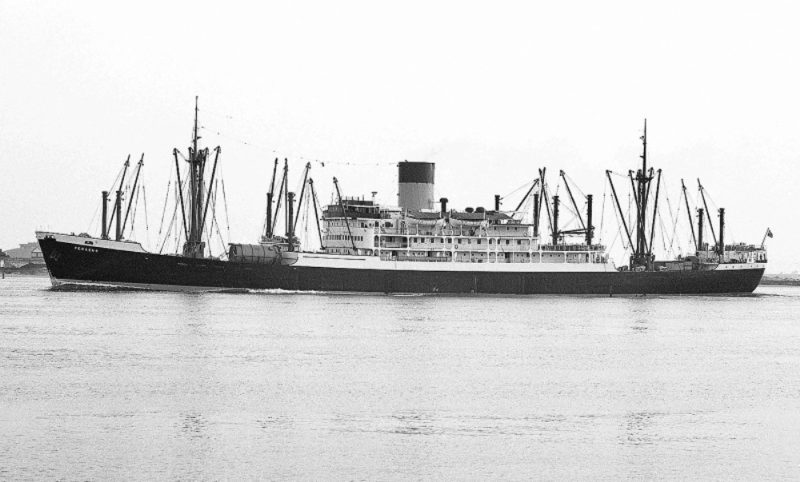
OCEAN TRANSPORT & TRADING Co. Ltd.
This rationalisation of the many shipping and business interests of the Blue Funnel Line, Elder Dempster Line, Glen Line, Ocean Titan Ltd., Cory Ship Towage, Ocean Liquid Gas, Ocean Ship Management, and distribution subsidiaries took place as Ocean Transport & Trading Co. Ltd. in 1972, just before the ‘P’ and ‘H’ classes were sent to the breakers yards. At the end of 1973, there were still a number of ‘A’ class post-war replacements or similar ships in service including Anchises renamed Alcinous, Achilles renamed as Asphalion, Cyclops, Autolycus, Antilochus, Laertes renamed Idomeneus, Bellerophon, Ascanius, Atreus,Alcinous renamed Polydorus,Laomedon, Eumaeus, Adrastus, Elpenor, Lycaon, Demodocus, Diomed,Dolius, Menelaus, Menestheus, Machaon, Memnon, and Maron. Agapenor and Melampus had been trapped in the Great Bitter Lake of the Suez Canal since June 1967 and had been abandoned to insurers in 1971.
The remaining ‘A’ class and their later similar ships were either sold off to foreign buyers or transferred to Elder Dempster Line for the U.K. to West Africa service by 1977, thus ending the Blue Funnel Line careers of the newbuilding classes that were needed to plug the gaps left by World War II losses. Anew ‘P’ class of eight cargo-liners of 11,600 dwt built in 1966/67 was in service, with five from the Walker Naval Yard on the Tyne, two by the Mitsubishi yard in Japan, and one from the famous Clydebank yard of John Brown & Co. Ltd. They had a very high service speed of 21 knots and ‘flat out’ could do up to 24 knots, but lasted only twelve years in service as the pace of containerisation was relentless. They were named Peisander, Priam, Protesilaus, and Prometheus for Blue Funnel Line, and Glenalmond, Glenfinlas, Pembrokeshire and Radnorshire for Glen Line, which had become a subsidiary of Blue Funnel Line in 1935.At the end of 1972, Glenalmond was renamed Patroclus, Glenfinlas was renamed Phemius, Pembrokeshire was renamed Phrontis and Radnorshire was renamed Perseus. Thus, during the last voyage of the original Perseus to the Far East for breaking up, there were two ships named Perseus in service with Blue Funnel Line during December 1972 and January 1973. Four other classic cargo-liners had been completed during 1962/63 for Glen Line in Glenogle and Glenfalloch from the Fairfield yard on the Clyde, and Glenlyon and Flintshire from the Dutch yards of the Nederland Dock & Scheeps at Amsterdam and the Van der Giessenyard at Krimpen.
The year of 1978 saw Ocean Transport & Trading Co. Ltd. dispose of eighteen cargo-liners to foreign owners, who could use them in the non-containerised routes, but the four vessel ‘M’ class of 1977 with a container capacity of 773 TEU and built by Mitsubishi at Nagasaki provided Blue Funnel Line with ships that could trade profitably in the 1980s. However, the sale of the Blue Funnel Line headquarters at India Buildings in Liverpool in 1988 with only one floor kept on lease marked the end of Blue Funnel Line, which did not have a single ship sailing on the high seas at that time.
Blue Funnel Line ships had been trading to the Far East very successfully for 123 years since the first trio of steamers Agamemnon, Ajax and Achilles had arrived at Singapore with blue funnels and black tops in 1865. This had seemed almost impossible to the huge number of Blue Funnel officers, ratings and other ranks when the post war rebuilding took place of 21 ‘A’ class cargo-liners and fifteen later similar ships plus the octet of the very fine ‘P’ and ‘H’ classes of cargo-liners in 1949/50.
Their seafaring lives were unfortunately to end for many of them so very abruptly with the advent of containerisation, with half of the Far East cargo trade containerised by 1973 and this had risen to 90% of the trade by 1978.


POSTSCRIPT
The classic profiles of the eight ‘P’ and ‘H’ class cargo-liners of 1949/50 made them great ships with a fast turn of speed of almost twenty knots when making up time due to delays, the like of which will never be seen again. In my opinion, and also that of many other pundits, the classic ‘P’ and ‘H’ class were the finest ships that ever sailed for Blue Funnel Line, and being fully loaded on both the outward and homeward voyages, they certainly very much looked the part. The size of the fleet had fallen in 1959 from 60 ships with more on the stocks and a further five under the ‘Oceaan’ N.V. subsidiary in Amsterdam, to 56 ships in 1964, 52 ships in 1971, to 43 ships in 1973 with 29 under Elder Dempster as part of the Ocean Transport &Trading Ltd. fleet, to only 13 cargo-liners with 5 running on charter to the worldwide Barber Blue Seas service in 1981, and finally no cargo-liners in 1988. A sad end to a very famous shipping company, one of the very best under the Red Duster of the British Merchant Navy.
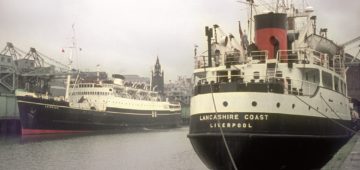



Comments
Sorry, comments are closed for this item